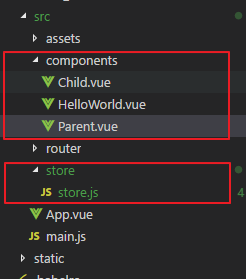Vuex的定义、个人理解和结构解析
vuex定义:vuex是一个专门为vue.js设计的集中式状态管理架构。
vuex的个人理解:
是存储公有状态数据state的一个仓库(store);解决了大型应用时组件传参的繁杂和不易维护性;vuex的状态储存是响应的,store中状态发生改变后相应组件会得到更新;不能直接修改store中的状态,唯一途径是显示的提交(commit)mutation, 可以通过getter获取state的派生值;
Vuex结构组成:

Store(仓库):
State(状态):负责存储应用的状态数据,可以理解为数据容器;组件中获取vuex中的数据时使用this.$store.state.stateName来获取;
Mutations(变化):利用它来更改状态state数据,本质是处理数据的函数,其接收唯一参数值state。我们可以在methods方法中使用this.$store.commit(‘mutationName’);来触发一个mutation的方法;必须是同步函数,否则devtool中的数据将会出现问题;
Actions:通过触发mutation来修改state状态,重要的是可以异步改变state状态,在methods方法中使用this.$store.dispatch(actionName);直接触发
Getters:有些状态需要进行二次处理就可以使用getters,可以在方法中使用this.$store.getters.valueName对派生出来的状态数据进行访问;当依赖发生改变时会改变
mapActions、mapMutations、mapGetters、mapState:是利用辅助函数将actions、mutations、getters、state映射到本地计算属性或methods方法中去;使用前需引入映射如: import {mapGetters} from ‘vuex’
vuex的demo实践:
第一步:创建项目
基于vue-cli脚手架生成一个vue项目;
常用命令:
npm i vue-cli --g 来安装vue-cli
vue --vesion 或 vue -V 来检查vue安装是否成功
vue init webpack 项目名 来创建vue-cli 脚手架项目
注意:当运行 npm i vue-cli --g 安装vue-cli报 “ WARN deprecated coffee-script@1.12.7: CoffeeScript on NPM has moved to "coffeescript" (no hyphen) ” 错误时可以尝试 使用 cnpm i vue-cli --g 安装
第二步:检查项目是否创建成功,安装vuex
npm run dev 来运行vue项目
npm i vuex --save 来安装vuex
第三步:代码实现父子组件通过vuex传递参数Demo
效果:

1、项目文件结构如下: 创建父子组件文件和store.js文件

2、Store.js文件引用vuex如下:
import Vue from 'vue';
import Vuex from 'vuex';//vue引用vuex
Vue.use(Vuex);//state状态数据容器
const state={testMsg:"state中的一行测试文本",parentMsg:"父组件原始文本",childMsg:"子组件原始文本",count:99,
}//修改satate的方法,就是state状态数据的处理函数
const mutations= {changeParentMsg:function(state,str){state.parentMsg=str;},changeChildMsg:function(state,str){state.childMsg=str;},
}//异步,通过commit触发mutations中的方法来修改state
const actions={changeParentTxt({commit},data){commit('changeParentMsg',data);},changeChildTxt:function(context,data){context.commit('changeChildMsg',data);},//上述两个方法中的参数使用{commit}和context均有效,context代表store本身
}//对获取到的state数据进行过滤修改
const getters={countNum:function(state){if(state.count>100){return state.count+100;}else {return state.count-50;}}
}//创建store实例,将在main.js文件中将它加入到vue实例对象中
export default new Vuex.Store({ //export default 是封装代码,使外部可用state, //依此加入到store对象中mutations,actions,getters,
});3、Main.js文件在vue实例中引用store对象:

将store实例从根组件中‘注入’到子组件中,子组件通过‘this.$store’调用
4、组件文件:
HelloWorld.vue
<template><div class="hello"><h3>测试文本如下:</h3><p>在组件模板中直接输出获取值:{{$store.state.testMsg}}</p><hr><Parent></Parent><hr><h4>getters获取state的值修改后如下:</h4><p>{{$store.getters.countNum}}</p></div>
</template><script>
import Parent from './Parent'
export default {name: 'HelloWorld',data () {return {msg: 'Welcome to Your Vue.js App'}},components:{Parent},
}
</script><!-- Add "scoped" attribute to limit CSS to this component only -->
<style scoped>
h1, h2 {font-weight: normal;
}
ul {list-style-type: none;padding: 0;
}
li {display: inline-block;margin: 0 10px;
}
a {color: #42b983;
}</style>
Parent.vue
<template><div><div class="parentContainer"><div><h3>父组件的内容:</h3><p class="txt">{{oldtxt}}</p></div><button class="btn" @click="changeParentTxt()">点击更改父组件内容</button><button class="btn" @click="changeChildTxt()">点击更改子组件内容</button></div><Child></Child></div>
</template>
<style>.parentContainer {height:150px;width:350px;background-color: lightblue;color:#fff;margin:10px auto;}.txt {border:1px solid red;padding:10px;}.btn {background-color: #fff;color: #000;}
</style>
<script>import Child from './Child'export default {name:"Parent",data(){return {}},components:{Child,},computed:{oldtxt:function(){return this.$store.state.parentMsg;}},methods:{changeParentTxt:function(){let newParentTxt="更改后的父组件内容变长的很多!!!";this.$store.dispatch('changeParentTxt',newParentTxt);},changeChildTxt:function(){let newChildTxt="这里是父组件点击修改后的文本内容....";this.$store.dispatch('changeChildTxt',newChildTxt);},},}
</script>
Child.vue
<template><div class="childContainer"><div><h3>子组件的内容:</h3><p class="txt">{{oldtxt}}</p></div><button class="btn" @click="changeChildTxt2()">点击更改子组件内容</button><button class="btn" @click="changeParentTxt2()">点击更改父组件内容</button></div>
</template>
<style>.childContainer {height:150px;width:350px;background-color: lightcoral;color:#fff;margin:10px auto;}.txt {border:1px solid red;padding:10px;}.btn {background-color: #fff;color: #000;}
</style>
<script>export default {name:"Child",data(){return {}},computed:{oldtxt:function(){return this.$store.state.childMsg;}},methods:{changeParentTxt2:function(){let newParentTxt="我这是通过子组件修改父组件state后获取到的文字!!!";this.$store.dispatch('changeParentTxt',newParentTxt);},changeChildTxt2:function(){let newChildTxt="点击子组件按钮后内容变成了这样!!!";this.$store.dispatch('changeChildTxt',newChildTxt);},},}
</script>
Vuex在项目中代码使用详解
1、组件模板获取state状态数据:将状态对象赋值给内部对象,也就是将stroe.js中的值赋值给模板中的data中的值,有三种赋值方式:
①使用computed计算属性直接赋值;
②使用mapState辅助函数来赋值(将state值映射到局部计算属性);
③使用mapState的数组来赋值;
<div>computed计算属性获取的值:{{count01}}</div><div>使用mapState辅助函数来赋值:{{count02}} </div><div>使用mapState的数组来赋值:{{count}} </div> computed:{ //多个computed时,后面的会覆盖前面的count01(){ //普通计算属性return this.$store.state.count;},...mapState({ //mapState(obj)对象辅助函数赋值count02:(state)=>{return state.count} //ES6的箭头函数}),...mapState(['count']) //mapState(arr)数组来赋值}
2、getters获取的是经过加工过滤后的state状态数据。
//store.js中getters定义
//对获取到的state数据进行过滤修改
const getters={changeCount:function(state){if(state.count>100){return state.count*2;}else {return state.count-1;}}
}const mutations= {addCount:function(state,num){return state.count+=num;},
}// 组件模板中使用mapGetters
<template><div class="childContainer"><h3>原值:{{count}}</h3><h3>getter加工过滤后的值:{{changeCount}}</h3><button @click="$store.commit('addCount',20)">点击数字加20</button></div>
</template>
<script>
import {mapState,mapMutations, mapGetters} from 'vuex'export default {name:"Child",data(){return {}},computed:{...mapState(['count']),...mapGetters(['changeCount']),},methods:{...mapMutations(['reduceCount']),},}
</script>
同理在组件模板可以通过this.$store.getters.changeCount来获取store中过滤更改后的count值;
mapGetters辅助函数和mapState辅助函数类似是将store中的getter 映射到局部计算属性computed中,mapGetters使用前先import引入;
3、组件模板更改store中的state值通过mutations中的方法:mutations同步更改状态($store.commit('mutationName'))的方式:
①使用this.$store.commit('mutationName');
//store.js
//mutations中更改satate的方法,就是state状态数据的处理函数
const mutations= {addCount:function(state,num){return state.count+=num;},reduceCount:function(state,num){return state.count-=num;},
} <button class="btn" @click="$store.commit('addCount',50)">点击使用commit直接触发mutations中的方法</button>
②使用mapMutations辅助函数将mutations中的方法映射到methods中;
a、组件中首先需要使用import 引入mapMutations和mapState(依赖性),如
import {mapState,mapMutations} from 'vuex'b、将mutations中的方法映射到methods中;
methods:{...mapMutations(['reduceCount']),
},c、组件模板中直接使用映射的方法如:
<button class="btn" @click="reduceCount(20)">通过mapMutations触发mutations中的方法</button>
4、actions异步更改状态state,actions方法通过mutations中方法来更改state,actions中的方法有两种写法如下:
//异步,通过commit触发mutations中的方法来修改state
const actions={changeParentTxt({commit},data){commit('changeParentMsg',data);},changeChildTxt:function(context,data){context.commit('changeChildMsg',data);},//上述两个方法中的参数使用{commit}和context均有效,context代表store本身
}mapActions的使用类似mapMutations将方法映射到methods中,组件模板使用前先 import 引用mapActions、mapMutations、mapState;
methods:{changeCountNum:function(){this.$store.dispatch("countNum_action",99); //$store.dispatch("actionName");直接触发actions中的方法},
},
5、module模块组:为解决state状态对象过多而杂的问题,我们将一个store划分为多个module模块,每个模块拥有自己的state、mutations、actions、getters使用如下
①store.js中是声明modules
//声明模块组module
const moduleA={state:{name:'zhangsan',age:27},mutations:{},actions:{},getters:{}
};const moduleB={state:{name:'wangwu',age:26},mutations:{},actions:{},getters:{}
};export default new Vuex.Store({modules:{a:moduleA,b:moduleB} //使用a做为moduleA的别名,b同理
});②模板组件中获取指定module中的state数据有以下两种方式
<div>模块A的name值是:{{$store.state.b.name}}</div>computed:{moduleAname:function(){return this.$store.state.a.name;}
},
PS附加:
1、如果store文件太大,也可以将 action、mutation 和 getter 分割到单独的文件。分割的文件需要export default 导出,并在store.js文件中的import 导入,如下
//mymutations.js 文件
const mutations= {changeParentMsg:function(state,str){state.parentMsg=str;},changeChildMsg:function(state,str){state.childMsg=str;},
}
export default mutationsimport state from './mystate'
import mutations from './mymutation'
import actions from './myactions'export default new Vuex.Store({state, mutations,actions,getters,
});2、在vue 的构造器里边只能有一个computed属性,如果你写多个,只有最后一个computed属性可用;
3、vuex数据在页面刷新时数据会丢失问题,解决思路是vuex更改state数据时同时存储到sessionStorage,当getters获取state数据时判断state为空时对应sessionStorage是否存在,为true则获取sessionStorage赋值给丢失了数据的stateName,如下:
//store.js中定义getters获取时为空会判断从sessionStorage获取值或初始值
const getters={countNum:function(state){if(!state.count){state.count=10; //首次num数值为空初始值赋值为10let sessionVal=sessionStorage.getItem("count_num");if(sessionVal){state.count=parseInt(sessionVal);}}return state.count}
}//store.js中定义mutations更改state后存储到sessionStorage
const mutations= {change_numCount:function(state,data){state.count=data;sessionStorage.setItem('count_num',data);},
}//组件模板中触发更改state状态数据的action方法
methods:{changeCountNum:function(){ this.$store.dispatch("countNum_action",99);},
},
参考网址:https://blog.csdn.net/H5_QueenStyle12/article/details/75386359
https://blog.csdn.net/mjzhang1993/article/details/78321903






方法的使用详解(简单明了))

,附niceScroll滚动条插件使用)
)

)






)
